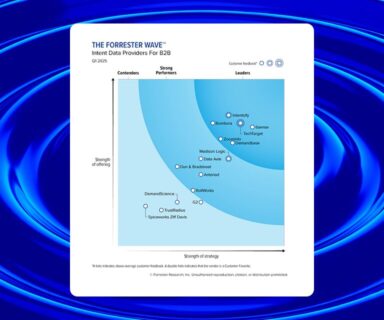Part of a three-part guide exploring some typical areas of difficulty organizations experience on the ABM development journey. Part 1 covers Sales, Part 2 covers Marketing and Part 3 covers Sales Development.
Identify and pursue target account entry points
 As Marketing gets better at engaging targeted ABM accounts, you want to make sure that your Sales Development team has a clear path to building on that progress. You’ll want to train them in new ways of building on momentum and create guardrails that prevent them from ignoring, or worse, destroying engagement inroads. You’ll want to adjust their KPIs accordingly and enable them with very structured guidance on how to nurture signs of interest rather than, for example, disqualifying whole accounts based only on an uninspiring interaction they may have had with a single individual. ABM progress in an account begins with identification of relevant buying centers. Attempting brute force to go at the top managers is one of the tactics that has probably failed you in the past. Now, in ABM, our experience shows that your next actions should be weighted towards engaging the people who populate that buying center – because these are the practitioner innovators who will be articulating and championing the need to implement something new. You need to get to these people and you may have to get to them through others. The point is, any engagement you achieve with the account has value because it moves you a little bit forward. Your SDR motion must not undermine this.
As Marketing gets better at engaging targeted ABM accounts, you want to make sure that your Sales Development team has a clear path to building on that progress. You’ll want to train them in new ways of building on momentum and create guardrails that prevent them from ignoring, or worse, destroying engagement inroads. You’ll want to adjust their KPIs accordingly and enable them with very structured guidance on how to nurture signs of interest rather than, for example, disqualifying whole accounts based only on an uninspiring interaction they may have had with a single individual. ABM progress in an account begins with identification of relevant buying centers. Attempting brute force to go at the top managers is one of the tactics that has probably failed you in the past. Now, in ABM, our experience shows that your next actions should be weighted towards engaging the people who populate that buying center – because these are the practitioner innovators who will be articulating and championing the need to implement something new. You need to get to these people and you may have to get to them through others. The point is, any engagement you achieve with the account has value because it moves you a little bit forward. Your SDR motion must not undermine this.
Identifying the foundational gaps causing underperformance of SDRs for any type of deployment is difficult enough, especially if you have not yet matured your management of the function to the point of making optimization of the function a recognized and supported responsibility. In a recent survey of Sales Development organizations, most companies reported that their teams achieved less than 70% of quota and only 17% were greater than 90%, so it’s fair to say there’s a lot of work to do out there. A range of issues contribute to this, including broken or unclear reporting structures, misaligned performance metrics and business goals, and time-consuming list creation processes. As you develop your ABM program, you’ll need to address these needs and more, because if these problems aren’t corrected, your Sales Development function becomes an impediment to ABM success rather than the important lever it can be.
For more insights on Sales Development improvement read, Set Up to Fail? How We’re Holding SDRs and Our Prospecting Back.
Leverage real intent data to drive higher quality SDR interactions
In parallel with closing the major gaps in Sales Development infrastructure, enablement and process, you will want to also focus on what’s actually happening at the sharp tip of the spear – how exactly are the SDRs interacting via the phone, email, text, chat and so on? These frontline players in the sales cycle have a very limited window to make a positive impression, but plenty of room to make a bad impression. To increase high-quality touches and cut down on negative ones, these people need a combination of the best available sales intelligence, presented very prescriptively and plenty of training in how to use it. With insights like those available from TechTarget’s Prospect-level™ intent data, every member of your team can have amazing knowledge of the people they’re reaching out to on the ABM list. It’s up to your support teams and your suppliers’ customer success organization to make sure the SDRs are continuously improving.
To learn more about increasing high-quality interactions with your buyers, read Beyond Activity Measures: Increase SDR Yields by Focusing on Quality.
Unlike SDRs, experienced sales professionals have built up an array of methods that have served them well. Especially when faced with challenging situations and difficult account histories (like those an ABM program may have been conceived to address), these professionals are often selected for their get-it-done track record. Yet these same experts, while individually highly innovative, can sometimes be slow to adopt relatively new toolsets and the potential nestled within them. While to a marketer, the promise of Prospect-level™ intent data may seem obvious and natural, leveraging it fully must not be left to chance, even with a sales rep A-team on the job. Whether your company’s ABM focus is on customer cross-sell/upsell, new logo acquisition, or otherwise, there are many ways your best sellers (and their management) can benefit from the right intent data source. Leveraged to accelerate and close opportunities against in-quarter quota, to build pipeline for the future or for practically any of the nuanced steps in between, real purchase intent data is one of the most powerful new tools you can give your best sellers, if you can support them in adopting it fully.
For more on using purchase intent data in strategic accounts, read How Sellers Can Provide a Better Customer Experience in the Current Business Environment.
How we can help
At TechTarget, we’re focused on delivering the very best in enterprise tech buyer insight from our opt-in audience of some 30 million members. Building on our intent data core, we deliver a wide range of service capabilities that help solve the most critical GTM challenges. We work with thousands of tech companies end-to-end – strategically, from product concept to in-market content, and executionally, from click to close. To learn more about how we can support your ABM evolution, speak to a TechTarget representative today.



